Conventions and Style - Part II
D. Surrealism
At first glance, surrealistic art looks realistic. Only by looking more closely into the picture do we see that that certain objects don't belong in the picture or are drawn in an incongruous manner. Surrealism is marked by the use of visual puns and irony. Anthony Browne is the master of picturebook surrealism. While his characters go blissfully about their daily lives, the background is chaotic, shadows fall in all directions, and objects that don't belong in that context appear. These illustrations from Gorilla show you what surrealism can look like.
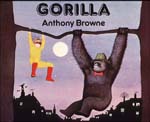
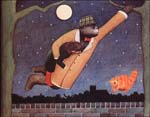
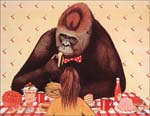
Chris Van Allsburg's books, particularly his earlier works such as Jumanji and The Mysteries of Harris Burdick, are also examples of surrealism. In Jumanji, we see the juxtaposition of wild animals such as lions, rhinoceros, and monkeys running though a North American house. In certain ways the illustration looks "real," until you realize that you just don't see these animals inside houses.

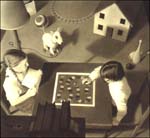
A better example might be the pictures in The Mysteries of Harris Burdick. Here you can see pictures of live birds coming off the wallpaper or a vine growing out of a book. The key is that at a first, quick glance, the picture looks realistic; it's only after looking more carefully at the details that you realize something is wrong.
You were not required to purchase this book; take a moment to visualize the concept.
E. Folk Art
Folk art is sometimes called naive art or primitive art because the artist is usually self-taught and the composition of the painting looks rough and unpolished. Folk art often lacks many of the conventions such as perspective that mark realistic art. Look at the the realistic painting of Paul Zelinsky's Rumpelstiltskin.
Compare Rumpelstiltskinwith the folk art in Swamp Angel. The folk art look fits the nature of the hyperbole of that tall tale.
![]() Go to the Web Resources link for Swamp Angel to see images and get more information.
Go to the Web Resources link for Swamp Angel to see images and get more information.
Tomie DePaola, Faith Ringgold, and Barbara Cooney also work in the style of folk art. For example, look below at an image from Barbara Cooney's Ox-Cart Man.

F. Cartoon
Cartoon art usually signals to the reader that the content of the picture will be humorous. Cartoon art tends to exaggerate some characteristic of what it is attempting to depict. Cartoons are marked by a strong sense of line; in fact, just a few well-drawn lines can suggest a pig, a hippopotamus, or a human being. Some of the better known illustrators who work in a cartoon style include: James Marshall, William Steig, and Betsy Lewin.
James Marshall - Red Riding Hood
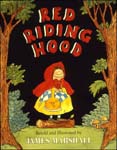

William Steig - Dr. Desoto
![]() Go to the Web Resources link for Dr. Desoto to see images and
get more information.
Go to the Web Resources link for Dr. Desoto to see images and
get more information.
Betsy Lewin - Click, Clack, Moo
![]() Go to the Web Resources link for Click, Clack, Moo (illustrated by Besty Lewin) to see images and
get more information.
Go to the Web Resources link for Click, Clack, Moo (illustrated by Besty Lewin) to see images and
get more information.
![]() The Kitamura book When
Sheep Cannot Sleep is done in a cartoon style. Take a closer look
at your copy of When Sheep Cannot Sleep to see this demonstrated.
The Kitamura book When
Sheep Cannot Sleep is done in a cartoon style. Take a closer look
at your copy of When Sheep Cannot Sleep to see this demonstrated.
